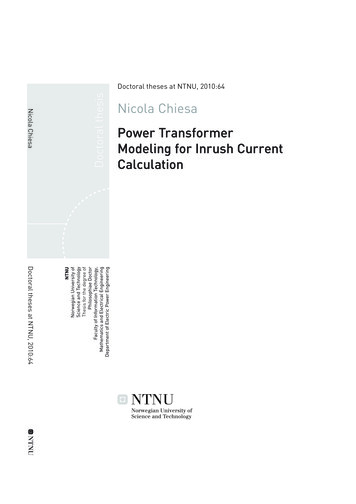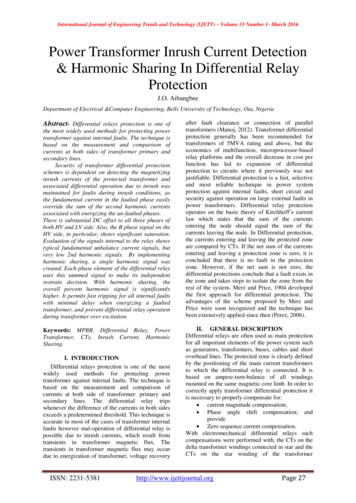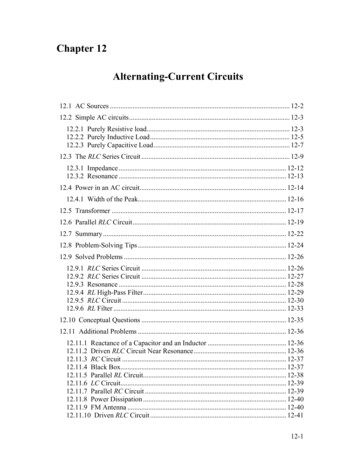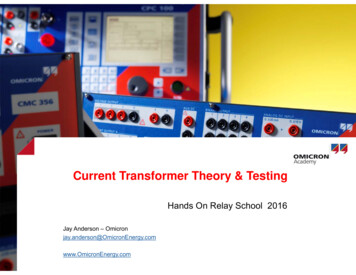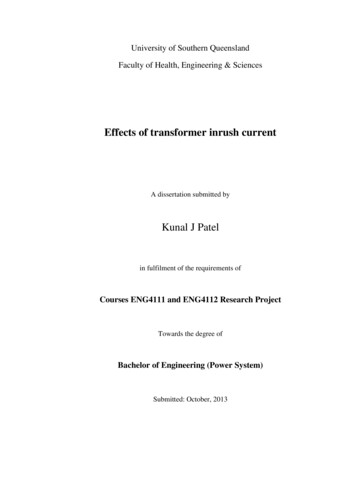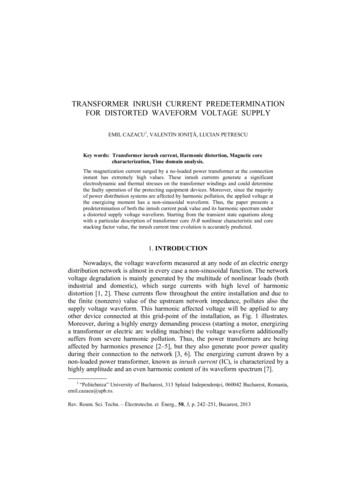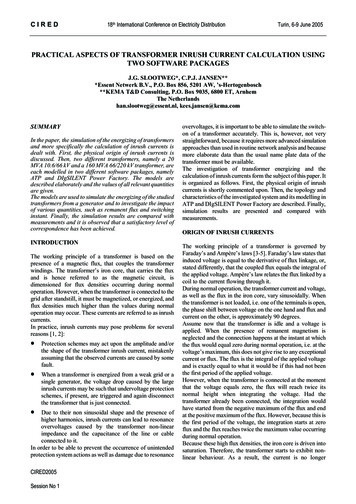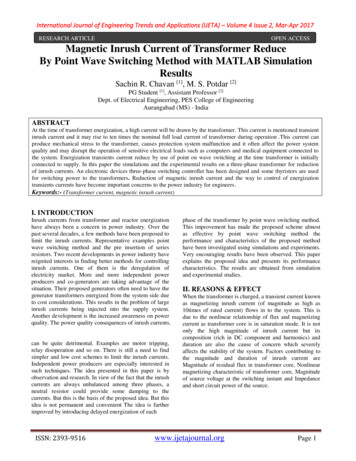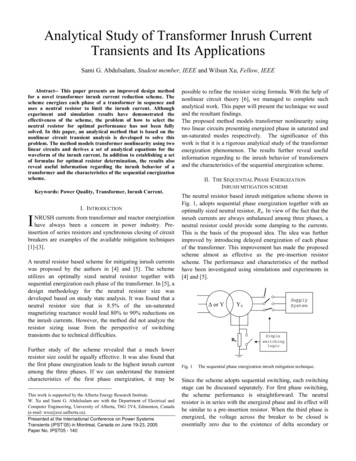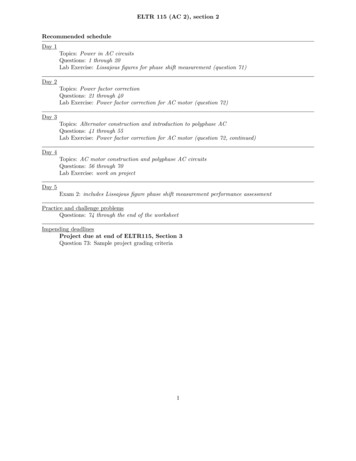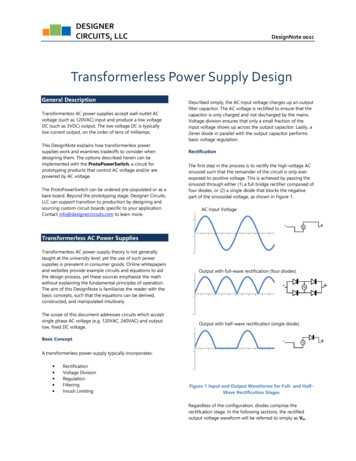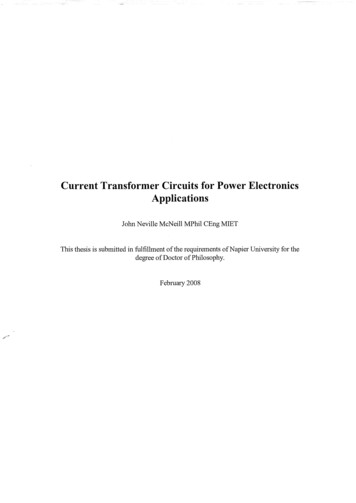
Transcription
Current Transformer Circuits for Power ElectronicsApplicationsJohn Neville McNeill MPhil CEng MIETThis thesis is submitted in fulfillment of the requirements of Napier University for thedegree of Doctor of Philosophy.February 2008
"Is there any knowledge in the world which is so certain that no reasonable mancould doubt it?"Bertrand Russell, "The Problems of Philosophy", 1912
ontribution to KnowledgevList of FiguresV11List of TablesxvList of Principal SymbolsxviList of Principal AbbreviationsxxiCHAPTERlIntroduction and Overview of Current SensingTechniques for Power Electronics Applications11.1Overview and Organisation of Thesis11.2Current Sensing Requirements in Switched-Mode PowerConverters21.3Overview of the Principal Current Sensing Techniques31.3.1The Sense Resistor31.3.2The Current-Sensing MOSFET51.3.3Use of MOSFET On-State Resistance as a Sense Element61.3.4The Hall-Effect Sensor71.3.5The Rogowski Coil91.3.6The Current Transformer10
1.4Other CT Applications in Power Electronics151.5Synchronous Rectification16CHAPTER 2Review of Current Transformer Circuits192.1Introduction192.1.1Unidirectional Current Pulse Sensing Using a CT192.1.2CT Equivalent Circuits212.1.3dc Current Sensing242.1.3.1Ancillary Circuitry for Core Material Resetting252.1.3.2Multi-vibrator Circuits252.1.3.3The Dual CT Circuit262.2Rectifier and Load Arrangements282.2.1Current Pulse Sensing with Load Resistance and DiodeRectification282.2.2Current Pulse Sensing with Active Output Stage and DiodeRectification292.2.3Current Pulse Sensing with Active Output Stage andSynchronous Rectification322.3CT Resetting Behaviour362.3.1Resetting into a Discrete Voltage Clamp Circuit362.3.2Natural Resetting into Stray Capacitances382.3.2.1Natural Resetting with Diode Rectification and LoadResistance422.3.2.2Natural Resetting with Diode Rectification and ActiveLoad422.3.2.3Natural Resetting with Synchronous Rectification andActive Load432.4Summary of Alternative Rectifier and Load Arrangements43
2.5Average Current Droop and Resonant Operation of the CT45CHAPTER 3The Unidirectional Current Pulse Transformer withDiode Rectification and Natural Resetting463.1Introduction463.2Theory of Resonant CT Operation with Lossless CoreMaterial463.3Effect of Net Magnetizing Current on Average CurrentDroop513.3.1Average Current Droop with Discontinuous MagnetizingCurrent and Lossless Core Material513.3.2Average Current Droop with Continuous MagnetizingCurrent and Lossless Core Material533.4Operation in Discontinuous Secondary Current Mode withLossless Core Material553.5Effect of Core Losses in the CT on Average Current Droop623.6Experimentation643.6.1Experimental Arrangements643.6.2Experimental Results703.6.3Experimental Results at Low Primary Currents793.6.4Comparison of Experimental Results with Theory823.6.5Relation of Average Current Droop to Core Material LossData843.7An Enhanced Loss Algorithm843.8Thermal Effects863.9Summary of Chapter87CHAPTER 4Diode Rectification in the Dual CT Arrangement withNatural Resetting884.1Introduction88
4.2Application of Core Loss Correction Algorithms to theDual Transfonner Arrangement with Diode Rectification884.3Effect of Inclusion of Second CT on Current Slope Sensedduring Power Device's On-Time914.4Experimentation924.4.1Experimental Arrangements924.4.2Exemplifying Circuit Wavefonns924.4.3Experimental Results954.4.4Discussion of Experimental Results964.5Summary of Chapter97CHAPTERSThe Unidirectional Current Pulse Transformer withSynchronous Rectification and Natural Resetting985.1Synchronous Rectification with Discrete MOSFET985.1.1Categorization of Synchronous Rectifier Topologies forUse with the CT1005.1.2Synchronous Rectifier Topologies with N-ChannelMOSFET1005.1.3Synchronous Rectifier Topologies with P-ChannelMOSFET1025.1.4Experimentation with Discrete MOSFET SR1045.1.4.1Experimental Arrangements1045.1.4.2Estimate of Effect ofCT Core Losses with SynchronousRectification1055.1.4.3Synchronous Rectifier MOSFET Gate Charge Effects1055.1.4.4Experimental Results with Discrete MOSFET SR1105.2Synchronous Rectification with Analogue Switch1155.2.1Experimental Circuit1155.2.2Experimental Results with Analogue Switch SR116
5.3Discussion of Experimental Results and Summary ofChapter119CHAPTER 6Application of Reset Voltage Feedback for DroopMinimization in the Unidirectional Current PulseTransformer1206.1Introduction1206.2Operating Principle1206.3Implementation of Circuit and Experimental Results1266.3.1Implementation1266.3.2Exemplifying Circuit Waveforms1286.3.3Comparison of Average Current Droop with ConventionalDiode Rectifier and Load Resistor Circuit1316.3.4Operation at Low Primary Currents1326.4Circuit Simulation1336.5Performance with Non-Rectangular Current Pulses1396.5.1Theory1396.5.2Experimental Readings with Triangular Current Waveform1416.5.3Comparison with Theory1436.6Discussion and Summary of Chapter144CHAPTER 7Application of Switched-Mode Circuitry for SupplyingCorrecting Voltage to the Unidirectional Current PulseTransformer with Reset Voltage Feedback1467.1Introduction1467.2Proposed Technique1477.3Implementation of Circuit and Experimental Results1487.3.1Implementation1487.3.2Exemplifying Circuit Waveforms150
7.3.3Comparison of Average Current Droop with ConventionalDiode and Burden Resistor Circuit1517.3.4Comparison of Measured Losses against Estimated Losses1527.4Circuit Simulation1527.5Discussion and Summary of Chapter154CHAPTERSConclusions1558.1Principal Findings1558.1.1Diode Rectification1558.1.2Synchronous Rectification1568.1.2.1Synchronous Rectification with Discrete MOSFET1568.1.2.2Synchronous Rectification with Analogue Switch1578.1.3Reset Voltage Feedback1578.1.3.1Reset Voltage Feedback with Linear Correction Stage1578.1.3.2Reset Voltage Feedback with Switched-Mode CorrectionStage1588.2Classification of Work Done against Existing Techniques1598.3Suggested Further Work159162REFERENCESAPPENDIX 1Publications Based on Work Carried Out for the Thesis172APPENDIX 2Droop Measurements from the Current Transformerwith Diode Rectification at Varying Frequencies173A2.1Introduction173A2.2Results173
APPENDIX 3Measurements of the Effect of Core Temperature onAverage Current Droop from the Current Transformerwith Diode l Arrangements175A3.3Results176APPENDIX 4Alternative Implementation of Linear Reset VoltageFeedback Scheme Using Discrete MOSFET179APPENDIX 5Linear Reset Voltage Feedback Scheme Realized inSurface-Mount Technology181
ACKNOWLEDGEMENTSThanks are due to my Director of Studies, Dr Naren Gupta of the School ofEngineering and the Built Environment, Napier University, for his advice andencouragement.The feedback received from Professor Phil Mellor, Dr Derrick Holliday, Dr SteveBurrow and others in the Electrical Energy Management Group within the Faculty ofEngineering at the University of Bristol is also gratefully acknowledged. In particular,the advice received from Dr Rafal Wrobel and Dr Dave Drury when discussingmagnetic materials and circuit simulations respectively has been much appreciated.Mr Will Drury and Mr Peter Constantinou are thanked for looking over chapters fromthe manuscript. The provision of research facilities and study time by the ElectricalEnergy Management Group is acknowledged. Thanks are due to Mr Richard Walkerfor photographing the experimental circuitry.
DeclarationThe work in this thesis is based on the research carried out at the School ofEngineering, Napier University, Edinburgh, UK. No part of this thesis has beensubmitted elsewhere for any other degree or qualification and it is all my own workunless referenced to the contrary in the text.Signed:rV " /7cN Dated:2 l'v/l 200311
ABSTRACTThis thesis investigates the operation of the current transfonner (CT) when sensingretum-to-zero current pulses in power electronic circuitry.The CT's output signal is nonnally rectified when sensing current pulses and theeffects of the different rectification techniques on peak current and average currentdroop are evaluated. Initially, the various current sensing techniques and theirapplication in power electronics circuits are reviewed. The CT and both diode andsynchronous rectification are then reviewed in more detail.Operation of the CT with diode rectification (DR) and natural resetting is investigated.Three operating modes are identified. These are the discontinuous magnetizingcurrent, continuous magnetizing current and discontinuous secondary current modes.The error (droop) in the average output signal obtained is found to be predominantlydefined by CT core losses. Coefficients are given for correcting the error due to droop,provided that the discontinuous secondary current mode is avoided. Dioderectification with the dual CT arrangement is also investigated.Operation of the CT with synchronous rectification (SR) and natural resetting is theninvestigated. The SR topologies possible using a discrete MOSFET are categorized.During experimentation the arrangement used to drive the MOSFET's gate is found tobe important if distortion is to be minimized. It also is found that the average currentdroop is dependent on the oscillatory behaviour of the resetting circuit and has aneffectively random component. The magnitude of this component is defined by thevoltage drop exhibited by the SR MOSFET's intrinsic anti-parallel diode.SR is then implemented using a commercially available analogue switch. Theproblems detailed with the use of a discrete MOSFET are largely alleviated. Anotherbenefit is that the increased restriction on maximum duty factor imposed byintroducing a discrete MOSFET is also eased. However, whichever SR technique isiii
implemented, an operational amplifier is used and the transient response of this circuitelement is important.A method of minimizing droop by indirect sensing of the CT's peak core fluxexcursion is then presented. A corresponding correcting voltage is applied in serieswith the CT's output terminals during a current pulse. The magnitude of this voltageis based on the magnitude of the resetting voltage sensed during previous switchingcycles. A circuit is implemented and simulated. Experimental results are presented.A switched-mode circuit operating at a frequency higher than that of the main powercircuit is then used to apply the correcting voltage with the objective of reducing thepower drawn. Again, the circuit is implemented and simulated and experimentalresults are presented.iv
CONTRIBUTION TO KNOWLEDGEThe main contributions claimed by the author are as follows:1. Operation of the current pulse transformer when used with diode rectification,an active load and natural resonant resetting is investigated. Three modes ofoperation are identified and described. These are the discontinuousmagnetizing current, continuous magnetizing current and discontinuoussecondary current modes. It is shown that, at certain combinations offrequency and duty factor, the error in the average output signal obtained ispredominantly defined by core losses in the CT. Simple piecewise power-lawand ramp-on-a-step correction terms dependent on duty factor are shown to beappropriate for substantially correcting the error due to droop, provided thatthe discontinuous secondary current condition is avoided.2. Average current droop in the dual CT arrangement when used with dioderectification has been evaluated. It is found that, although applying thecorrection terms used with the single CT arrangement may be ideal, asubstantial reduction in droop may be achieved in this case by the simplerapproach of adding in a fixed offset term which is independent of duty factor.3. Although factors for correcting the average current droop due to core lossesmay be introduced, two criteria have to be satisfied. Firstly, accurate data onthe CT's core losses is required. Secondly, the core losses should ideallyexhibit a temperature coefficient of zero. With ferrite materials in particular,the losses vary non-linearly with temperature over the typical operatingtemperature of a CT. An additional important practical issue is that the op-ampshould exhibit symmetrical positive and negative-going slew rates.4. Natural resonant resetting of the current pulse transformer when used withsynchronous rectification (SR) realized with a discrete MOSFET isinvestigated. The possible SR topologies are categorized. It is found that thearrangements used to drive the SR MOSFET's gate are important if unwantedtransient output signals and steady-state distortion in the circuit's output signalv
are to be avoided. The error in the average output signal obtained is alsoinfluenced by the oscillatory behaviour of the resetting circuit and has aneffectively random component, the magnitude of which is defined by thevoltage drop exhibited by the SR MOSFET's anti-parallel diode.5. Using an analogue switch is preferred for realizing SR as this problem islargely alleviated, as is the distortion introduced by the presence of theMOSFET's inter-terminal capacitances and gate charging current. However,the transient (slewing) performance of the operational amplifier still affects theminimum droop attainable.6. An active technique is investigated for reducing droop in the CT. This isapplied to a CT in an otherwise conventional diode rectifier and resistive loadconfiguration. Feedback is applied such that the CT's secondary terminalvoltage is preset during a current pulse in response to the resetting voltagesensed during previous switching cycles. A circuit implementation has beeninvestigated, results are given and a simulation has been presented. It is foundthat, in steady-state operation and with integral feedback, average currentdroop may be effectively removed if the current waveform is rectangular. Thisincludes operation at low primary currents where the problem of operation inthe discontinuous secondary current mode is virtua
CHAPTER 3 The Unidirectional Current Pulse Transformer with 46 Diode Rectification and Natural Resetting 3.1 Introduction 46 3.2 Theory of Resonant CT Operation with Lossless Core 46 Material 3.3 Effect of Net Magnetizing Current on Average Current 51 Droop 3.3.1 Average Current Droop with Discontinuous Magnetizing 51
